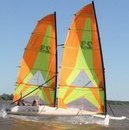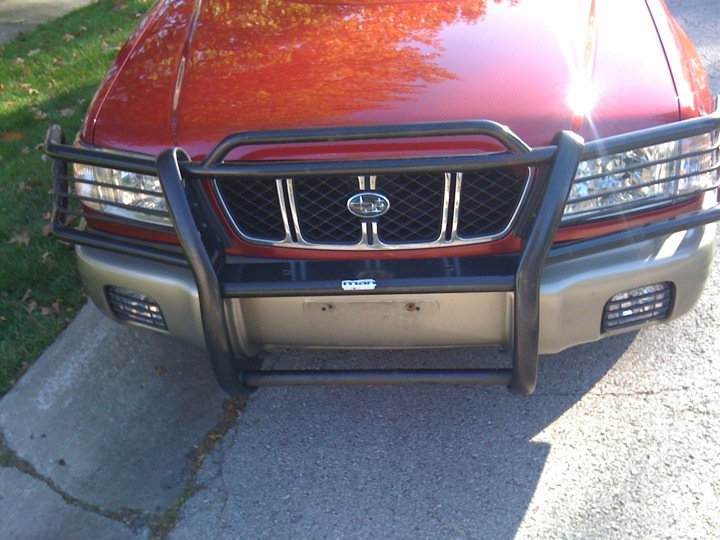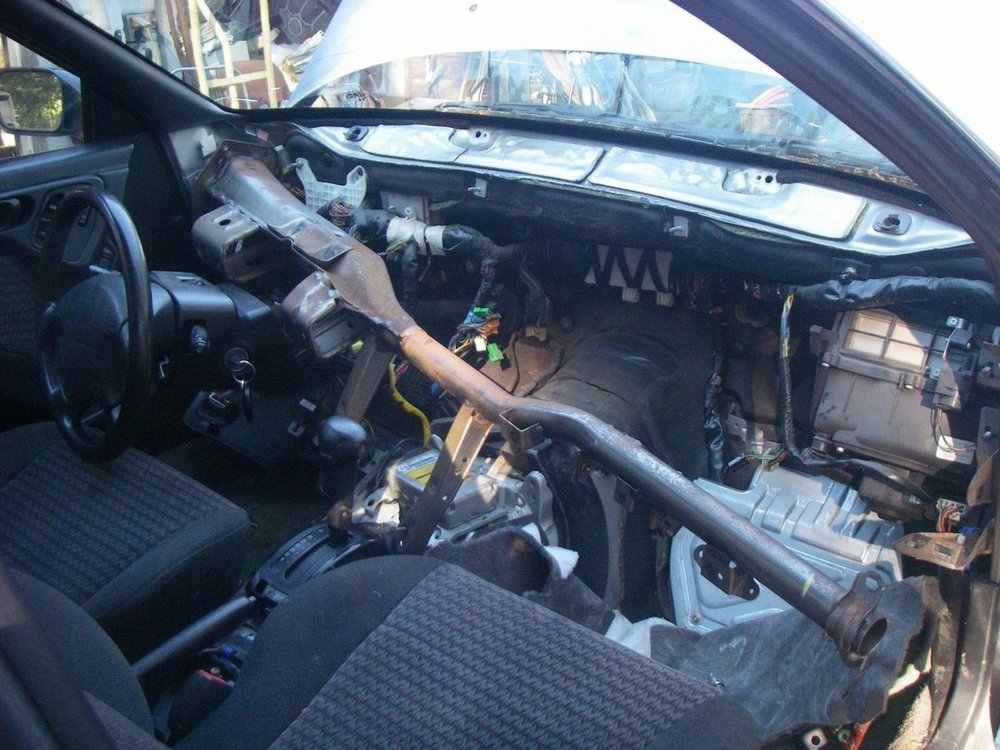-
Posts
832 -
Joined
-
Last visited
-
Days Won
24
Content Type
Profiles
Forums
Gallery
Store
Everything posted by jonathan909
-
As discussed (OT) in another thread, deer have wiped out two Foresters (1999 and 2002) for us this year. As nice as the insurance settlements were, I'm really not interested in going through all that again. So, for the newest (2001), I'd like to get a hardcore grille guard, something like this. I found the pic online via another forum, but there was no information on who manufactured it. Can anyone offer any leads?
-
I'm not sure what you mean. I don't know whether there's snow/ice on the ground in Maryland at the moment, but if there is, if you get moving on a slippery road and hit the brakes and lock the wheels, do you feel the ABS buzz in the pedal? If so, it's "mostly" working and there's probably a specific fault (like one wheel sensor not feeding the ABS controller) to be debugged vs. a systemic failure that would indicate it had been somehow disabled. To me, "multimeter" means volts, ohms, and (milli)amps, so I'm assuming you're talking about some kind of ODBII (yeah, I know it's supposed to be OBD, but I like the Wu Tang reference) device. No matter; the way to diagnose the fault is with the diagnostic pin and blinkenlicht method mentioned above.
-
If what you mean by "traction control" is a transmission function, you're looking in the wrong place. The ABS light is connected directly to the ABS unit and performs a couple of functions. First (as you're seeing now), it's letting you know there's something wrong with the ABS. But that includes the ABS unit being disconnected altogether - the ABS connector has an integral switch that turns on the light if it's unplugged. You didn't say whether the ABS is working at all (which would be helpful). So you should first check to see that it's plugged in, then look to the fuse box and make sure they're all there (there are a couple that serve the ABS), as the easiest way for someone to disable the ABS would be to yank the fuse. Then, if all that looks sound, connect the diagnostic pin under the dash (there's another thread here a few days old that'll give you further info) and see whether there are any codes to read out via the ABS light blinkety-blink.
-
I'm kinda in the same neighborhood with my wonderbeater '95 Legacy - it's a (stripped-down) Brighton, but a few years ago I was given a new hatchback to replace the original, which was rusting through. The replacement has a wiper, which was not present in the original, so I snagged the combination switch as well from the donor car, but haven't yet gotten around to installing it. As I recall, the rear wiper connector was present in my car's harness, so I'm hoping that the remainder of the harness, and in particular, the connector for the combination switch, will support the rear wiper as well. I don't have a lot of confidence in the possibility, though, having seen other cases in which you'd think the harness and connectors would be there, but aren't. I'm thinking in particular of retrofitting seat heaters into my wife's '98 Legacy DD. I don't get why they don't simplify the inventory at the factory and just use the same harness for every car, which would ease the installation (i.e. by the dealer) of options that a buyer later decided he/she wants. I get that omitting a few feet of wire and a couple of connectors reduces the cost of that harness by a few pennies, but speaking from the perspective of a design engineer, I think it's a poor tradeoff.
-
D@mn straight. That's the rule: Do not swerve to miss a deer - hitting the ditch is more likely to kill you, and the deer is unlikely to do more than damage the car and die (though the first one I really nailed a few years ago went high, blew half the windshield into my face, and pushed the roofline back about six inches). But you have to swerve to miss the moose, because they're both heavy and high, and sure to come through the windshield and kill you. A near-miss of a moose at night is just about the most terrifying thing you can imagine, because as you pass it at speed in a small, low car like a Legacy it looks ten or twenty feet tall. It's really a weird effect, and lots of people report it. A friend of mine who used to have a Ferrari had a much more amusing story about one of the other guys he drove with (I can't remember whether his was another Ferrari or a Lamborghini) hitting a deer out in my neighborhood, and since the car was so low it scooped the viscera and blew it all into the passenger compartment...
-
I should have noted the valve clearances before I stripped this motor down, but failed to do so. Before I start pulling the valves out of the heads for cleaning, lapping, new seals, etc., I'd like to get those "before" measurements. But the TSM only gives them based on the rotational position of the right (passenger) side cam sprockets, which doesn't help me a lot with just the left side head on the bench. So is there something that shows what the correct positions of the left side cams are for measuring lash, or is this just a dumb question?
-
Sure - a highly volatile degreaser like trichloroethylene is residue-free, but that strikes me as a pricey way to clean CV components. They're really referring to common cleaners, esp. the varsol we have in our parts cleaning tanks. Anyone who uses gas as a cleaning solvent (indoors) deserves to have the fumes creep into his basement and blow his house off its foundation. Gasoline is evil.
-
I don't really know enough about this, but I do note that when I replaced a couple of CV boots last summer (the kits came with grease packets) the instructions were quite specific about not cleaning the joints with solvent, because the solvent residue may break down the grease. They indicated soap and water only.
-
This is actually a fairly complicated system, so while it's possible to set up a test jig for diagnosing it on the bench, it's not very practical. Stick with diagnosing it in situ. Also, the TSM goes into detail about diagnostics via the SSM (Subaru Select Monitor), but I have no idea whether any of the PC or smartphone apps like FreeSSM support it. Anyone? Short of swapping in a replacement unit, the diagnostic charts really only offer one potential fault for what you're seeing. Under: TROUBLE CODE DOES NOT APPEAR. DIAGNOSIS: Diagnosis circuit is open. TROUBLE SYMPTOM: The ABS warning light turns on or off normally but the start code cannot be read out in the diagnostic mode. the only possible (serviceable) fault described is that your diagnostic pin grounding isn't making it to the ABS unit. In other words, the diagnostic ground pin (the dangling one) isn't actually connected to ground, OR the diagnostic input pin is bad, OR the wire between that connector and the ABS connector is bad, OR the ABS connector pin is bad. So you can check this with your DVM: Plug in the diagnostic ground under the dash, unplug the ABS connector from the unit, and check for continuity between the diagnostic pin (PIN 4, if I'm reading the diagram properly) in the harness connector and ground. That's about it. Wrt the bleeding, yeah, I've felt that pain. I just replaced all the struts on my '01 Forester (did I mention I wrote off TWO Foresters this year thanks to deer?), and those idiots threaded the brake lines through brackets on the struts, so changing the struts meant bleeding the brakes, and both rear bleed nipples were rusted hard and twisted off, so after snapping an easy-out it was off to the store for a couple of new cylinders. Grrr....
-
That's exactly how it sounds. From the TSM: -> When there are no trouble codes in memory, only the start code (11) is shown So you should at least get that when you ground the diagnostic pin and turn the key. And make sure you've grounded the right pin and that you're getting the sequence right: 1. With diagnostic pin disconnected, drive the car. ABS light goes on. 2. Stop car, turn ignition off. Ground diagnostic pin. Turn ignition on. Codes blink. I don't have a lot of experience with these things, but did get a feel for it while battling my (late) '02 Forester. I'm also guessing that all of the ABS units are common (someone please correct me on this if I'm off base). My sense of it is that your ABS controller is NFG, but it's still weird that it's alive enough to raise an error, but not able to report it. The unit is entirely self-contained, so you can't just swap in a new controller. Perhaps there's a yard closer to you, but there's a Pick -n-Pull in Hammond, and they charge $64 (plus core) for an ABS unit: http://www.picknpull.com/part_pricing.aspx?LocationID=66&NavItem=1&SearchCriteria=&#partpricing I'd try stuffing in a replacement from the wrecker and see if it behaves differently. Note that the connector has a lock that you have to slide out in order to disengage it, and (of course) you're going to have bleed all four wheels (a PITA). But that'd be the route I'd take. P.S. You also said "For good measure we tried to ground the other pins as well." That's a bad measure, not a good one. You can't predict the results when you do stuff like that. Stick with grounding only the specified pin.
-
I'm not sure I can help, but with no replies yet I can hear you twisting in the wind and feel your pain. One of the wonkiest faults I've dealt with was after swapping a new motor into a '99 Outback. I won't relate the whole saga, but cut to the money shot. I'd managed to leave untightened the most obvious ground, which is also the one that's not documented in the factory manual: The one on top of the intake, next to the coil pack. The symptoms were that the 3-4 shift point kept drifting all over the place and it was throwing all kinds of spurious TCU errors e.g. complaining about not being able to commmunicate with the ECU. Bad grounds will kick your @$$. You've tried the ECU swap. If you can lay your hands on a spare TCU (I'm lucky enough to have a couple of very cheap self-serve yards nearby) you might learn something by swapping it in. But the "no crank" thing is a different level altogether - that's not a complicated circuit. If the connections are good, there's not much left other than battery, starter, and keyswitch. Can you force it to crank by applying +12 to the solenoid input?
-
That stuff works, huh? I'll certainly try it first if there's a next time. I didn't much enjoy the heater core replacement on my '99 Outback, and wasn't impressed that I was forced to lose the AC charge in the process. "Serviceability" should have dictated that the heater core be removable without the evaporator having to come out too.
-
I know it's not much compared to having it rebuilt (I was quoted $2500 CDN), but pretty dear compared to the self-serve yards here. Spring '17 I replaced the 4EAT in my '99 Forester - found an exact match in the boneyard. It was a rough afternoon dropping it on my own (I'd had a major rotator cuff repair - graft - only a few months before and was trying really hard not to trash it, and it was a blazing hot/dry day and I'd forgotten my water bottle...), but it cost $135 ($100 USD today) and worked a champ - until the car was nailed by a deer a year later.





